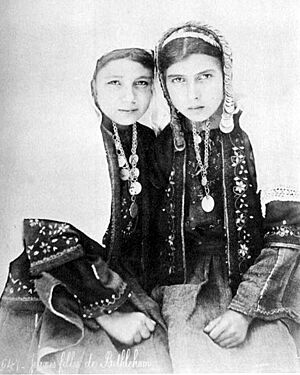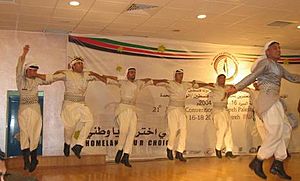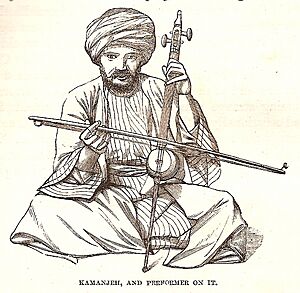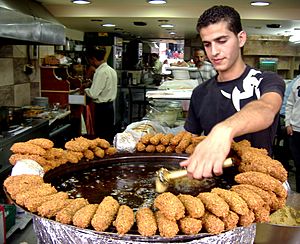Culture of Palestine facts for kids
The Culture of Palestine is all about the way of life for the Palestinian people. These people live in the State of Palestine, in the wider region historically called Palestine, and in many other countries around the world. Palestinian culture has been shaped by many different cultures and religions over a long time, starting from the ancient Canaanite period.
Palestinian culture includes things like food, dance, legends, oral history, and customs. Even though Palestinians live in different places, their art, literature, music, clothing, and food all show their shared identity. Many Palestinian thinkers have worked to bring back old cultural roots, especially from the Canaanite and Jebusite times. This has led to special events like the Canaanite festival in Qabatiya and the annual Music Festival of Yabus.
Contents
- Traditional Palestinian Clothing
- Palestinian Folk Dance
- Traditional Stories and Legends
- Palestinian Music
- Architecture in Palestine
- Sports in Palestine
- Modern Palestinian Art
- Modern Palestinian Cuisine
- Palestinian Cinema
- Palestinian Handicrafts
- Palestinian Thinkers and Writers
- Palestinian Literature
- Modern Palestinian Poetry
- Modern Palestinian Music
- Images for kids
- See also
Traditional Palestinian Clothing
In the late 1800s and early 1900s, people visiting Palestine often noticed the wide variety of traditional clothes worn by Palestinians. This was especially true for women from villages, known as fellaheen. Until the 1940s, most Palestinian women could tell a lot about another woman just by looking at her dress. They could tell if she was married or single, and which town or area she was from. This was shown by the type of fabric, colors, cut, and embroidery on her robe-like dress, called a "thoub" in Arabic.
After the Palestinian exodus of 1948, many people were forced to leave their homes. This made it hard for women to spend time or money on making complex embroidered clothes. New styles started to appear in the 1960s. For example, the "six-branched dress" got its name from the six wide bands of embroidery that ran down from the waist. These new styles came from the refugee camps, especially after 1967. Over time, the unique styles of individual villages became less common. Instead, a more general "Palestinian" style of clothing became popular.
Palestinian Folk Dance
Dabke (Arabic: دبكة) is a lively Arab folk dance that comes from the Levant region. It is very popular in Palestinian culture. Many dance groups perform the Dabke all over the world. The Dabke involves synchronized jumping, stamping, and quick movements, similar to tap dancing.
Traditional Stories and Legends
Palestinians have a rich tradition of storytelling. Before a story begins, listeners are often invited to bless God and the Prophet Mohammed or the Virgin Mary. Stories usually start with the classic phrase: "There was, in the oldness of time..." Many parts of these stories are similar to those found in other Arab countries. However, the rhyming patterns are unique. The stories often feature magical characters like Jinns and Djinns, who can cross oceans in an instant. There are also giants and ghouls with glowing eyes and brass teeth.
Palestinian Music
Traditional Palestinian songs often do not have fixed lyrics. Instead, they have a set rhythm that allows for improvised poetry. One style of this folk singing is called Ataaba. It has four verses that follow a specific pattern and rhythm. The special thing about ataaba is that the first three verses end with the same word, but that word means three different things. The fourth verse then acts as a conclusion. Ataaba is still performed at weddings and festivals in Arab localities in Israel, the West Bank, and the Gaza Strip.
Other traditional Palestinian song styles include zajal, Bein Al-dawai, Al-Rozana, Zarif – Al-Toul, Al-Maijana, Sahja/Saamir, and Zaghareed. Over the past 30 years, the Palestinian National Music and Dance Troupe (El Funoun) and Mohsen Subhi have given new life to traditional wedding songs like Mish'al (1986) and Zaghareed (1997).
Architecture in Palestine
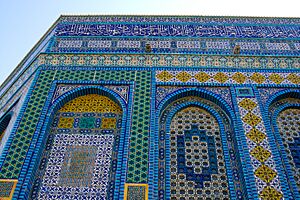
Traditional Palestinian architecture covers a very long time and many different styles. Before 1850, the buildings in Palestinian cities were quite advanced. While they were part of the larger building styles of the Levant and the Arab world, they also had their own distinct look. Palestinian homes shared basic ideas about how living spaces were arranged, similar to other parts of the Eastern Mediterranean. This mix of styles came from trade along caravan routes and the long period of Ottoman rule from the early 1500s until the end of World War I.
Sports in Palestine
Palestinian athletes have taken part in every Olympic Games since the 1996 Summer Olympics. The Palestinian Olympic committee also participated in the 2013 Mediterranean Games.
Sports in Palestine during the British Mandate era started with games inherited from the Ottoman period. These included horse racing, running, wrestling, and swimming. However, football quickly became very popular.
The first social-athletic clubs in Palestine began in the early 1900s, especially in the 1920s. Since then, sports, particularly football, became a big part of Palestinian culture. Many of these clubs started as social and cultural groups and later added sports activities. By 1948, there were about 65 athletic clubs in Palestine. Around 55 of them were part of the Arab Palestine Sports Federation (APSF), which was founded in 1931. These clubs greatly influenced young Palestinians, helping to shape their character and prepare them for community involvement.
Today, there is a West Bank Premier League and a Gaza Strip League for football. The Palestine national football team has played in international matches, including qualifiers for the 2014 FIFA World Cup and the 2015 AFC Asian Cup.
Other sports include rugby, with the Beit Jala Lions team in the West Bank. The Turmus Aya Equestrian Club, started in 2007, helps Palestinians access horses. The founder, Ashraf Rabi, believes that "horses are a big part of our Arab culture and we must embrace it."
Modern Palestinian Art
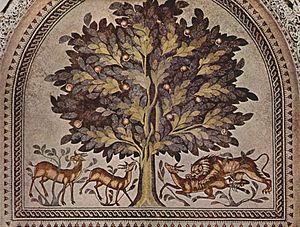
Palestinian art is found in four main places:
- the West Bank and Gaza Strip
- Palestinian communities in the Arab world
- Europe, the United States, and other places.
Modern Palestinian art is based on folk art and traditional Christian and Islamic painting. After the Palestinian exodus of 1948, many artists started using nationalistic themes. They use different art forms to show their connection to their identity and land. In the 1990s, artists like Salam Dyab and Hisham Zreiq began to use modern styles and symbols in their work.
Modern Palestinian Cuisine
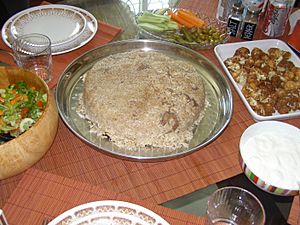
Palestine's long history of being ruled by many different empires has greatly influenced its food. Palestinian dishes have benefited from various cultural contributions. Generally, modern Palestinian food has been shaped by three main Islamic groups: the Arabs, the Persian-influenced Arabs, and the Turks. The original Bedouin Arabs in Syria and Palestine had simple cooking traditions, mainly using rice, lamb, yogurt, and dates.
The food of the Ottoman Empire, which included Palestine from 1512 to 1514, already had a rich Arab influence. After the Crimean War, many foreign groups like Bosnians, Greeks, French, and Italians started settling in the area. Jerusalem, Jaffa, and Bethlehem were popular places for these groups. Their cooking, especially from the Balkans, added to the unique taste of Palestinian food. However, until the 1950s and 1960s, the main diet for many rural Palestinian families was olive oil, oregano (za'atar), and bread baked in a simple oven called a taboon.
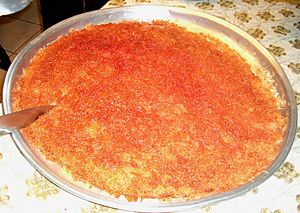
Palestinian food is divided into three regional groups: Galilee, West Bank, and Gaza. Food in the Galilee region is very similar to Lebanese food because of the close ties between the two areas before Israel was created. People in Galilee are known for making dishes with bulgur, spices, and meat, called kibbee. Kibbee can be served raw, fried, or baked.
Musakhan is a common main dish that came from the Jenin and Tulkarm areas in the northern West Bank. It is made with roasted chicken on a taboon bread. The bread is topped with fried sweet onions, sumac, allspice, and pine nuts, cooked with plenty of olive oil. Other common meals in the area include maqluba and mansaf.
The food in the Gaza Strip is influenced by nearby Egypt and its location on the Mediterranean coast. Fish is a main food for most people there. Gaza has a big fishing industry, and fish is often grilled or fried. It is usually stuffed with cilantro, garlic, red peppers, and cumin, then marinated in a mix of spices and chopped lemons. The Egyptian influence is also seen in the frequent use of hot peppers, garlic, and chard to flavor many Gaza meals. A dish unique to Gaza is Sumaghiyyeh. It is made with water-soaked ground sumac mixed with tahina, then added to sliced chard, stewed beef, and chickpeas.
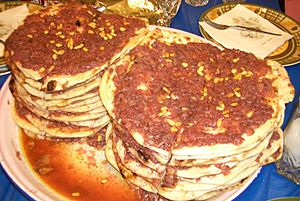
Several Palestinian foods are well-known throughout the Arab world. These include Kinafe Nabulsi, Nabulsi cheese (from Nablus), Ackawi cheese (from Acre), Rumaniyya (from Jaffa), Sumaghiyyeh (a stew from Gaza), and Musakhan. Kinafe and the sweet Nabulsi cheese used in it both came from Nablus. Baqlawa, a sweet pastry, is also a big part of Palestinian food.
Chickpea-based falafel, which replaced the fava beans used in the original Egyptian recipe, is a favorite food in the Mediterranean. Waraq al-'inib (boiled grape leaves wrapped around cooked rice and ground lamb) is also eaten throughout the Palestinian areas. Mahashi is a mix of stuffed vegetables like zucchinis, potatoes, cabbage, and in Gaza, chard.
Palestinian Cinema
Palestinian cinema is quite new compared to Arab cinema in general. Many Palestinian movies are made with support from Europe and Israel. Palestinian films are not only in Arabic; some are made in English, French, or Hebrew. More than 800 films have been made about Palestinians, the Israeli–Palestinian conflict, and related topics. Famous examples include Divine Intervention and Paradise Now.
Palestinian Handicrafts
Palestinians have been making many types of handicrafts for hundreds of years, and they still do today. Palestinian handicrafts include:
- embroidery and weaving
- pottery-making
- soap-making
- glass-making
- carvings from olive wood and Mother of Pearl
Palestinian Thinkers and Writers
In the late 1800s and early 1900s, Palestinian thinkers were important parts of wider Arab intellectual groups. Examples include May Ziadeh and Khalil Beidas. Palestinians have traditionally had high levels of education. In the 1960s, the West Bank had a higher percentage of teenagers (15 to 17 years old) enrolled in high school than Israel. Claude Cheysson, a French Minister, said in the mid-1980s that Palestinians "probably already had the largest educated elite of all the Arab peoples."
Palestinians living in other countries, like Edward Said and Ghada Karmi, and those who are Arab citizens of Israel, like Emile Habibi, have contributed to many different fields. This shows the wide range of experiences and ideas among Palestinians.
Palestinian Literature
The long history of the Arabic language and its rich written and spoken traditions are part of Palestinian literature. This literature has grown over the 20th and 21st centuries. Since 1967, many experts have said that Palestinian literature exists in three main "branches," based on where the writers live:
- from inside Israel
- from the occupied territories
- from among the Palestinian diaspora (Palestinians living outside Palestine)
Modern Palestinian Poetry
Poetry, using old forms from before Islam, is still a very popular art form. It often draws thousands of Palestinian listeners. Until about 20 years ago, local folk poets who recited traditional verses were common in every Palestinian town. After the 1948 Palestinian exodus, poetry became a way to express political feelings. Among Palestinians who became Arab citizens of Israel after 1952, a style of "resistance poetry" was born. This included poets like Mahmoud Darwish, Samih al-Qasim, and Tawfiq Zayyad. For many years, the wider Arab world did not know much about the work of these poets because Israel and Arab governments did not have diplomatic relations. This changed after Ghassan Kanafani, another Palestinian writer, published a collection of their work in 1966. Palestinian poets often write about feelings of loss and living away from home.
Modern Palestinian Music
Palestinian music is well-known throughout the Arab world. It often talks about the Palestinian experience, including struggles, the wish for peace, and love for the land of Palestine. After the Palestinian exodus of 1948, a new group of performers emerged. Their music had clear Palestinian themes, reflecting dreams of statehood and growing national pride.
Since the 1990s, Palestinian hip hop has become popular. This style mixes traditional Palestinian folk music and Arabic melodies with hip hop beats. These artists see themselves as continuing a "longer tradition of revolutionary, underground, Arabic music and political songs that have supported Palestinian Resistance." They use this style to share their feelings about the social and political situations they live and work in.
Images for kids
See also
 In Spanish: Cultura de Palestina para niños
In Spanish: Cultura de Palestina para niños


